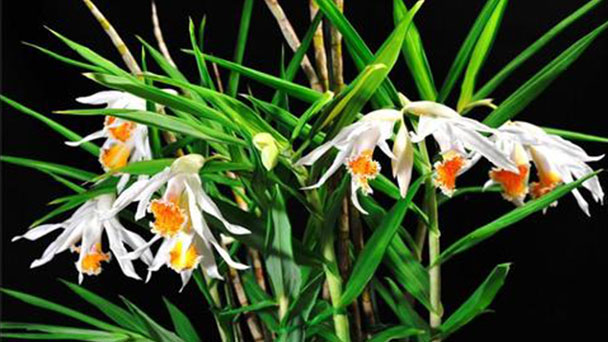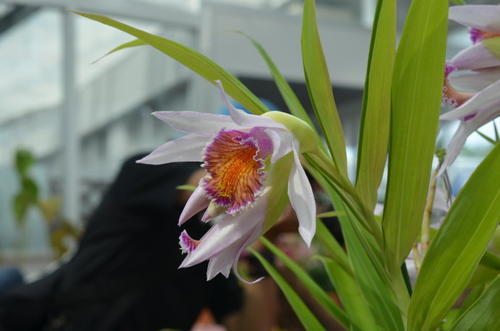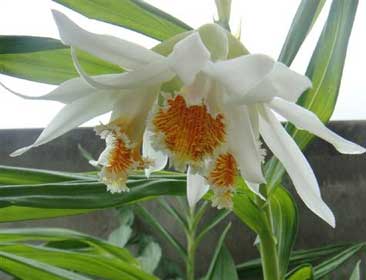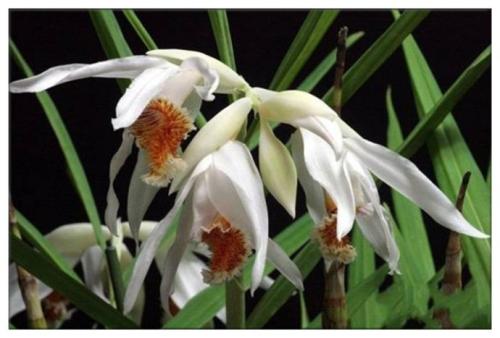Thunia alba profile
Written by Maggie
Mar 25 2021

Thunia alba is an terrestrial or epiphytic herb with erect, stout, cylindrical stems, thin papery leaves, narrowly elliptic or narrowly elliptic lanceolate, racemes 4 -- 10 cm long, with 2 -- 7 large flowers, white, yellow labellum with orange or chestnut spots and stripes, only white margins, and elliptic capsules.
Thunia alba is mainly grown in southwest Sichuan (Yanbian, Muli, Miyi, Mianning), southwest to south Yunnan (Zhenkang, Jingdong, Jinghong, Mengla, Menghai) and eastern Xizang in China, with flowering in June and fruit in unknown. thunia alba was born in the forest on the rock or tree recess, also seen on the stony ground, 1200-2300 meters above sea level.
Thunia alba is found mainly in Nepal, Sikkim, India, Myanmar, Vietnam, Thailand, Malaysia and India, and also in Nicaea.
Thunia Alba picture

Morphological characteristics of Thunia Alba
Thunia alba is a terrestrial or epiphytic herb, 30-55 cm tall, with short stubby rhizomes and numerous fibrous roots underground. Stem is erect, stout, cylindrical, usually with more than 10 alternate leaves, a few stem sheath at the base, initially all enclosed in the leaf sheath, autumn leaves shed only a tubular sheath, like a knobby bamboo shoot. Leaves are thin papery, narrowly elliptic or narrowly elliptic-lanceolate, 10 -- 20 cm long and 2.5 -- 5 cm wide, apex long acuminate or acuminate, base with tubular sheaths and encrusting stems, related nodes, leaves falling after anthesis leaving only tubular sheaths; The tubular sheath is 2-4 cm long, later becoming dry membranous.
Racemes of Thunia alba are 4 -- 10 cm long, with 2 -- 7 flowers;Bracts large, broadly elliptic to narrowly elliptic, navicular, 3-5 cm long, thinly leathery, persistent; Pedicels and ovaries are 2.5-3 cm long; Flowers are large, white, labellum yellow with orange or chestnut spots and stripes, margin white only; Sepals are narrowly oblong, 4 -- 5 cm long, ca. 1.5 cm wide, apex acuminate; Petals and sepals are subequal, slightly narrow; Lower sepal is broadly ovate-oblong or broadly oblong, several undivided, 4-5 cm long, 2.5-3 cm wide, upper margin wrinkled, irregularly fringed or rodent; The upper part of the labial disc has 5-6 flaps, flaps irregularly split into short tassels; Spur is cylindric at base, ca. 1 cm long, 3-3.5 mm wide, apex obtuse; The stamen column is about 2 cm long.
Capsule elliptic, ca. 4 cm long and 2 cm wide.
Thunia alba stem
Thunia alba is a terrestrial or epiphytic herb, 30-55 cm tall, with short stubby rhizomes and numerous fibrous roots underground. Stem is erect, stout, cylindric, usually with more than 10 alternate leaves, the base of several pieces of leaf sheaths, early all wrapped in the leaf sheath, autumn leaves fall off after leaving tubular sheath, section seems more bamboo thunia alba leaves thin paper, narrow elliptic or elliptic-lanceolate, 10-20 cm long, 2.5 5 cm wide, apex long acuminate or acuminate, base with tubular sheath and stem, the relevant section, flower leaf litter after leaving only tubular sheath; The tubular sheath is 2-4 cm long, later becoming dry membranous.
Thunia alba spends
Racemes of Thunia alba are 4 -- 10 cm long, with 2 -- 7 flowers; Bracts are large, broadly elliptic to narrowly elliptic, navicular, 3-5 cm long, thinly leathery, persistent; Pedicels and ovaries are 2.5-3 cm long; Flowers are large, white, labellum yellow with orange or chestnut spots and stripes, margin white only; Sepals are narrowly oblong, 4 -- 5 cm long, ca. 1.5 cm wide, apex acuminate;
Petals and sepals of Thunia alba are subequal, slightly narrow;Lower sepal broadly ovate-oblong or broadly oblong, several undivided, 4-5 cm long, 2.5-3 cm wide, upper margin wrinkled, irregularly fringed or rodent; The upper part of the labial disc has 5-6 flaps, flaps irregularly split into short tassels; Spur is cylindric at base, ca. 1 cm long, 3-3.5 mm wide, apex obtuse; The stamen column is about 2 cm long.
Thunia alba fruit
Capsule of Thunia alba is elliptic, ca. 4 cm long and 2 cm wide.
Ecological habits of Thunia Alba
Thunia alba is found on underforest rocks or in hollow trees, and also on rocky ground, at an altitude of 1200-2300 m.
Thunia alba generally grows on the mountainside and valley wall of deep mountains and valleys, sloping slopes or stone crevices with good water permeability and water retention, near sparse mountain grasses and under the shade of secondary miscellaneous trees. Or have shade, sunshine time is short or only the place where the star leaks light. Where the air is moist and can circulate, it is sometimes born on the side of mountain streams and cliffs.
Thunia Alba is best grown in a well-ventilated environment. Thunia alba likes shade, avoid direct sunlight, like wet, avoid dry, 15℃ to 30℃ most suitable for growth. Poor growth above 35℃. Cold temperature below 5℃ will affect its growth, when the orchid is often in a dormant state. If the temperature is too high and the sun is exposed to the sun, the leaves will burn or scorch within a day or two. If the temperature is too low and does not transfer into the house in time, there will be frostbite.
Thunia alba are fleshy roots, which are suitable for sandy loam rich in humus. The drainage performance must be good. Leaf-rot soil or mountain soil with more humus should be selected. Slightly acidic loose soil or soil containing iron, pH value of 5.5-6.5 is appropriate.
How to grow and care for Thunia Alba
Light
Thunia alba wants a mild stage of 20000-30000 lux. The mild must be filtered or dispersed, and the vegetation ought to now not be uncovered immediately to the solar in the afternoon hours. Strong air motion need to be ensured all the time.
Temperature
Thunia alba is a plant with reasonable warmness requirements, however requiring cool nights at rest. In summer, the common day temperature is 23-25 ° C, the night time 16-17 ° C, which gives a day by day distinction of 6-9 ° C. In the spring, at the quit of the wintry weather dry season, the common temperature of such a spring day is 27-28 ° C, the night time 10-16 ° C, and the each day span lowers from 18 to 11 ° C. In iciness the common day temperature is 22-25 ° C, the night time 6-7 ° C, which offers a each day distinction of 15-18 ° C.
Humidity
The White Thunia wishes the humidity of 80-85% in summer time and early autumn, regularly reducing to 60-65% at the stop of wintry weather and early spring.
Substrate, developing media and repotting:
Thunia alba have to be grown in extraordinarily ethereal containers stuffed with loose, rapidly drying ground. It is endorse a substrate consisting of 1/3 of oily clay, 1/3 of well-fermented manure, 1/6 of reduce roots of Osmund fern and 1/6 of tree fern fiber. Others endorse the use of a substrate composed of equal components of peat, clay and sand. Also, substances that launch the substrate however regularly maintain a component of the moisture, e.g. perlite and reduce sphagnum moss, are frequently delivered to such a mixture. Wood charcoal is additionally regularly delivered to make certain the air permeability of the substrate and safety towards acidification.
When the substrate starts to spoil down, the vegetation should be repotted, due to the fact they react very badly to the stable soil round the roots. It is suggest repotting in spring when new growths appear. After repotting, the vegetation should be positioned in a warm, moist and reasonably shaded area. Watering can be started out solely when new increments attain a top of 15-20 cm, that is, when their new roots are already growing.
Watering
In the length from late spring to autumn rainfall is average to heavy. Subsequently, the rainfall drops sharply and the length of 4-5 months starts to dry, lasting till the following spring. The vegetation must be watered abundantly throughout intervals of intensive growth, however first-rate drainage ought to be ensured so that the floor round the roots is in no way unfold or soggy. The quantity of water ought to be decreased in autumn, when the leaves flip yellow and begin to fall.
Fertilizer
During the energetic growth, the plant need to be fertilized each and every week 1/2-3/4 of the encouraged dose of fertilizer for orchids. You can use balanced fertilizer for the duration of the year, however can additionally use fertilizer with expanded nitrogen content material from spring to mid summer, and then in the late summer season and autumn, use a fertilizer with a greater content material of phosphorus.

How Thunia Alba propagates
Thunia alba is mainly propagated by branching. Thunia alba can be propagated in spring and autumn, and usually every three years.
Any plant with strong growth and dense pseudocorms can be divided, and at least 5 connected pseudocorms should be stored in each cluster after division.
Before planting, reduce irrigation water, so that the basin soil is more than. After planting, cover the bottom hole of the pot with broken tiles, then lay coarse stones, which account for 1/5 to 1/4 of the depth of the pot, then put coarse-grained soil and a small amount of fine soil, and then plant with sandy loam rich in humus.
Planting depth to the false corm just buried in the soil strength, basin edge to leave 2 cm along the mouth, spread grass or fine stones, finally pouring permeable, shady place for 10-15 days, keep the soil moist, gradually reduce watering, normal maintenance.
Disease control of Thunia Alba
Sheath rust
Usually on the upper and lower surfaces of the Thunia alba leaves, rarely on the stem with raised vesicles containing yellow, orange, rusty, or even purplish black powdery spores. Rust is not fatal, nor does it kill the leaves, but it weakens the plant. Prevention methods in addition to cutting off the sick leaves, can be used 65% of the sun zinc powder 500-600 times the liquid or containing copper fungicides spray.
Southern blight
Mostly in the rainy season. At the beginning of the disease, the leaf base is full of white mycelium. Prevention and control method: remove fungus basin soil, sprinkle on pentachloronitrobenzene powder or lime. Radical cure method: pay attention to ventilation and light, basin soil drainage is good.
Anthrax
It occurs all the year round, and is more prevalent in hot and rainy seasons, especially in Thunia alba. The spots first extend from the tip of the leaf to the rhizome, brown at the beginning, and then gradually expand and increase, there are many dry black spots, which lead to the death of the whole plant in serious cases. Prevention and control methods: in addition to actively change the environmental conditions, in the onset period, can be used first with 50% methyl tobujin wettable powder 800-1500 times the liquid spray treatment, once every 7-10 days; Then supplemented with 1% equivalent Bordeaux liquid, once every half a month, continuous spray 3-5 times.
Scale insects
Commonly known as "lice". They propagate fastest in conditions of high temperature, humidity and poor air flow. It can be sprayed with 1% diethoate oxide or 1500 times 50% mala sulfur during incubation period.If the number of POTS is not much, it can also be brushed manually.
Species classification of Thunia Alba
Thunia Alba, Orchidaceae, 5 species, distributed from India, Thailand to Indonesia, including Thunia Albat. Alba (Lindl.) Reichb.f. Also produced in Yunnan, Sichuan and Tibet. The genus has showy flowers and some species are available for viewing. Terrestrial or epiphytic orchids; Stem long and erect, caespitose, without pseudobulbs; Leaves multinomial, related node; Racemes terminal, with large persistent bracts; The flowers are large and showy; Lower sepal with 5 or more longitudinal ridges, short spur at base; The core column is slender, with two narrow wings at the top, without the core column foot;3 cleft of stamen beak; Pollen mass 8, waxy, with pollen mass stalks.
The distribution area of Thunia Alba
Thunia Alba is mainly distributed in China, Nepal, Sikkim, India, Myanmar, Vietnam, Thailand, Malaysia and Indonesia.
Thunia Alba is distributed in southwestern Sichuan (Yanbian, Muli, Miyi, Mianning), southwestern to southern Yunnan (Zhenkang, Jingdong, Jinghong, Mengla, Menghai) and eastern Xizang in China.Also distributed in Nepal, Sikkim, India, Myanmar, Vietnam, Thailand, Malaysia and Indonesia.
Thunia Alba's uses
Ornamental value
Thunia alba has several flowers with large, persistent, boat shaped bracts and large, showy flowers for viewing.
Landscape use of Thunia Alba
Thunia Alba has high horticultural value.

Latest Updated
- Benefits of Bugleweed - 7 Science-backed Health Benefits
- Bugleweed Dangers & Side Effects - Is It Poisonous?
- How to Plant Evergreen Trees - What You Should Know
- When to Plant Evergreens - Grow Guide for Evergreen Trees
- 12 Wonderful Evergreen Shrubs for Your Garden
- 12 Popular Evergreen Plants with Pictures for Beginners
- When And How To Prune A Lilac Bush Like a Pro
- How to Grow & Care for Lilac Vine (Hardenbergia Violacea)
- Japanese Lilac Tree (Syringa Reticulata) Care & Propagation Guide
- Shumard Oak Pros and Cons - What to Know
Popular Articles
- Winter maintenance of Antirrhinum Majus
- How to Grow Terminalia Mantaly Tree
- How to Grow and Care for Crossostephium Chinense
- How to grow Antirrhinum Majus in spring
- Peristeria Elata (Dove Orchid) Profile: Info & Care Guide
- Underwatered Snake Plant (Sansevieria Trifasciata) - Signs And How To Fix
- How to Care for Brazilian Jasmine Plant (Mandevilla Sanderi)
- How to Grow & Care for Graptopetalum Purple Delight in Summer
- Rosa Chinensis (China Rose): Plant Growing & Care Tips
- How to Care for Baby Sun Rose (Aptenia Cordifolia)